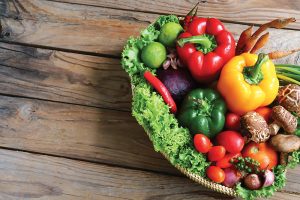Celebrating food in Southern Georgian Bay
When I was invited to write this column over a year ago, I was given a very wide berth. As a lover of food and community, I was asked to share my passions and include a recipe or two along the way. I welcomed the opportunity to express my wonder at what surrounds us here in Southern Georgian Bay, including rolling hills of apple orchards, vineyards of grapes with views stretching to the Bay, and pick-your-own establishments where families commune with food at the most basic level. I also used the space to delve into the politics of food and the challenge to live and eat with a conscience.
What was missing from my columns, however, was a common thread. When my editor, Janet Lees, asked me what that thread might be, I didn’t have an answer right away. We chatted for close to an hour and what became clear, as we dug deeper into my relationship with food, was that I kept coming back to the story behind the food. Where did my food come from? How did I come across it? Who grew it and how?
Sometimes I feel as if I am a bit of a braggart, going on about all there is on offer here in Southern Georgian Bay.
“Can you believe this pork came from two working artists who basically taught themselves how to become pig farmers on YouTube. And it’s Berkshire!”
“Let me tell you about this tortiere: the recipe is decades old and the pastry is killer ….”
“Can you taste the difference in these tomatoes? I swear he puts sugar in his water …”
Believe me, I’ve been the recipient of my share of eye rolling and thought bubbles along the lines of, “Here she goes again, regaling us with her tales of superior sourcing.”
But I am proud of what I bring to the table and honoured to be among a growing community of producers and consumers who share this pride by putting everything they can into making their food the tastiest, healthiest, happiest, most sustainable and locally sourced it can be.
There have always been stories behind our food, and we all have our own, mostly based on memories (good and bad). There are a few cookbooks in my collection that, when I pick them up, fall open to a favourite page, stained with remnants of essential ingredients, dog-eared a thousand times and in some cases loose from the binding all together. These recipes have been used so many times it’s a wonder I have not memorized them. But the pages are part of the memory, sparking recollections of times spent in the kitchen cooking with my mother, alone with the radio or with my boys standing on chairs beside me.
I have cookbooks from Spain, where my family spent our holidays while I was growing up. It contains my mother’s favourite recipes, along with memories of visiting the local markets, sampling olives and staring in awe at the dozens of varieties of fish laid out on crushed ice. There are cookbooks made by volunteers from the area where I have cottaged my entire life. Memories of making ‘Georgian Bay Pancakes’ with my sisters have morphed into family traditions that now include my own children.
Over the last two decades, the stories I spin around food have grown to include not only memories but experiences as well. Sharing laughs and insights with producers while hearing tales of wily critters in the garden, last night’s frost or the hormonal challenges of hens who refuse to lay, all contribute to my chosen profession as a cook/caterer.
When I started out as a young cook, friends and family in the business often reminded me that life would be much easier if I bought my supplies from one wholesaler. In one delivery I could have everything I needed, from tomatoes to frozen New Zealand lamb, even tortière. At the young age of 20 I wasn’t interested. Some of my goods would come from such wholesalers, but whenever and wherever I could, I sourced local. I would start the season travelling from market tents to butchers to fish mongers, introducing myself and my menu ideas and setting up accounts over hour-long meetings. This was, and still is, one of my favourite parts of the job. This is where the magic starts.
When I first set up shop in a small restaurant north of Parry Sound, the local, organic, 100-mile craze hadn’t entered the general food vernacular yet, but the story behind locally sourced food and the people who provided it was making its way into my cooking. The relationships I forged with producers gave my food meaning; from behind my food counter or while catering a cocktail party, I shared where the food came from and why it was featured on my menu. Looking back, it was a cutting-edge approach, but at the time it was simply what made my work enjoyable (it also led to a love of storytelling and a future career in journalism).
Today, in an age of hashtags, tag lines and name brands that all promise local or organic (and I’m thankful that this is so), we have come to expect the best from our food, but seldom do we get the whole story. Beginning in 2017, this column will serve that purpose.
In the coming months and seasons I want to celebrate the stories that truly take our food from farm to table. I will introduce you to friends and strangers who have decided to devote their time to putting real food on our plates while sharing their vision and inspirations. I will include recipes to help with those random cuts of meat we get when we order a ‘lamb bundle’ from the farmer down the road or those turnips in your Community Supported Agriculture (CSA) basket, provided by the couple from the market whose story is better than fiction. I want the stories to give your food flavour. I want you to devour them like a fresh apple pie and feel just as satisfied.
With time I am discovering that the table is my temple and in a perfect world all my meals would have meaning. But living in a busy time, leading busy lives with plenty of distractions, it is often difficult to find that meaning. I hope this column helps fill that void. I hope it encourages us to source the story behind our food so that when we are celebrating during family holidays, enjoying get-togethers with friends or savouring slow Sunday night dinners, the stories might begin to flow, and the meaning behind our food will surface, making us richer for the telling. ❧
Recipe
This decades-old favourite is our family’s go-to recipe for breakfasts any time of the year.
To get the full farm-to-table benefits, we use fresh local berries in the summer, local apples in the fall and local frozen fruit in the winter.
These pancakes always taste great. My mom used this recipe when I was growing up and never once did I see pancake mix in her pantry. Now that I have my own family, you won’t find any in mine, either. These just taste better and they are oh-so-easy.
As I record the recipe for the purpose of this column, I am looking at a sheet torn from the binding of its cookbook; the page has multiple stains, including the telltale circle of a once steaming cup of coffee. It is folded permanently over in the corner and it is frayed along the edges. All of these are signs of a tried-and-true recipe that will continue to be a staple and will be passed on through the generations.
Georgian Bay Pancakes
Serves 4
- 1 cup flour
- 1 Tbsp sugar
- 2 tsp baking powder
- ½ tsp salt
- ½ to 1 cup milk (amount depends on how cakey or crepey you like your pancakes)
- 1 egg, beaten
- 1 Tbsp melted butter or vegetable oil (plus a little more for frying pancakes)
- Fruit of your choice (blueberries, peaches, strawberries, apples, bananas)
Directions:
- Mix dry ingredients
- Mix egg and milk and add to dry ingredients
- Add melted butter or oil
- Gently fold in fruit
- Heat oil in frypan
- Add large spoonful of batter and fry until bubbles appear
- Flip and fry until golden
Serve with local maple syrup, apple butter or honey and enjoy!
Adapted from The Cottage Cookbook.










